While Albania’s beaches have seen considerable hype lately, if you ask me which destination is the most interesting I would absolutely say the capital. Tirana is a magnetic place full of surprises that has lifted itself up from its grey past in brazenly colorful ways.
What makes exploring it so fascinating to me is peeling back the many layers of its transformation. From being lost in a maze of underground bunker tunnels built under the communist regime, to standing on top of Tirana’s iconic Pyramid, once dedicated to its dictator but now a symbol of Albania’s reinvention — Tirana tells the story of a country that refused to stay buried.
Mind you, if you’re looking for Old European charm and historic cobbled streets, Tirana can’t really help you there. It’s a relatively new city, becoming more prominent only after being designated as Albania’s capital in 1920 — and nearly all of it is modern. If you see “Tirana Castle” on a map and go there expecting to see Medieval towers, you will be disappointed to find only a modern walkway lined with overpriced restaurants (oh, and one remaining wall).
But… Tirana captures you in different ways.

It’s a proud display of creative, even daring, architecture. It’s bursting with trendy cafes and cosy terraces. And its highly compelling museums will open your eyes to Albania’s darker days under its communist dictatorship that lasted until 1992.
I’m a travel freak so I tend to be forgiving even to places that can take some convincing at first (such as Bulgaria’s Sofia, another Balkan capital I visited last year and which can take a certain eye to appreciate). But Tirana, while it’s an emerging destination and still rough around the edges in some ways, feels ready for mainstream tourism.
Let me guide you to some of the best experiences in Tirana based on exploring it twice — in 2021 and 2025.
Don’t miss Tirana’s best experience!

Many tourist focus only on the communist-era sights, but if you want to experience something truly Albanian, The Albanian Nights is a must-do!
This cultural evening showcases traditional music, dance, and folklore — an energetic experience that had me smiling ear to ear. You’ll wear authentic costumes, can participate in the performances and, if you like, pair it with a seven-course traditional dinner.
I recommend booking directly with Albanian Nights to support their mission of sharing Albanian culture.
Get your tickets nowHow many days do you need?
If you are planning to travel around Albania for, say, a week, or if for you the capital is merely a waypoint towards Albania’s beaches, then I’d suggest spending at least one whole day in Tirana. Be sure to do a walking tour, go to one of the Bunk’art museums, and absorb as much of the atmosphere while you’re here.
In terms of how much there is actually to do, I’d say there is at least 2 to 3 days worth of pure sightseeing in Tirana. This increases if you include a day trip to Bovila Lake or Kruje, mentioned later. Consider a longer stay in Tirana if you have the time available.
Of course, if you’re a slow traveller or nomad you can stay even longer and explore the city’s hidden corners, but for most people several days should be enough to get a good taste of Tirana.
Planning your Tirana trip – some FAQs
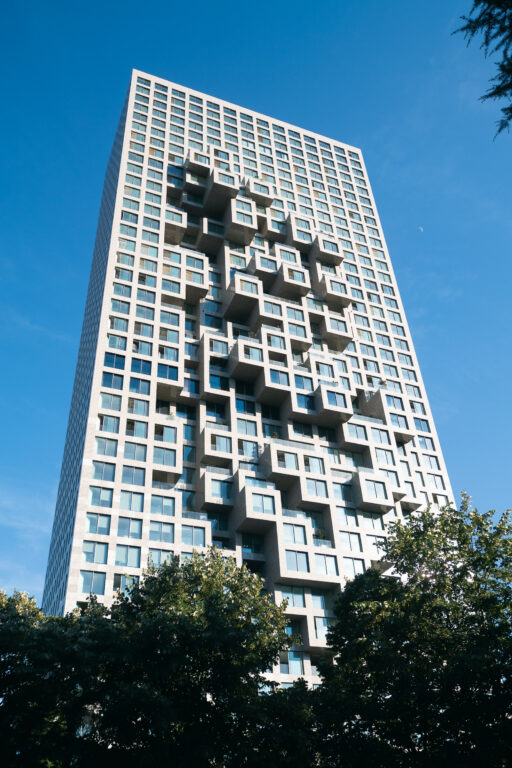

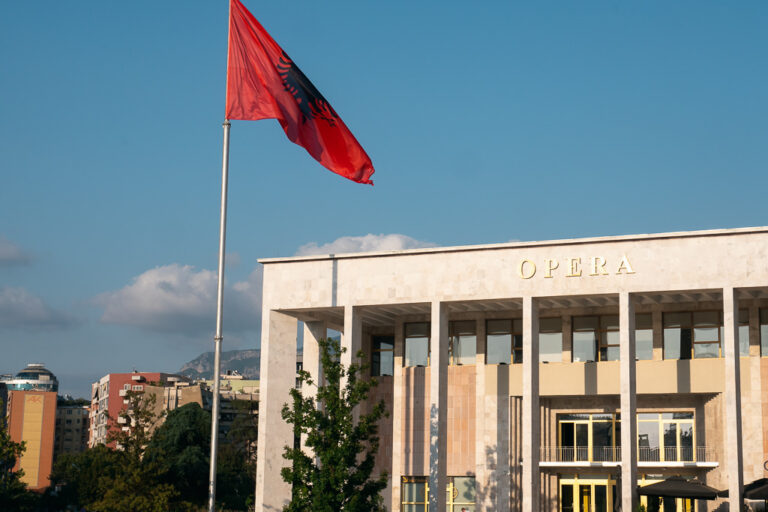
I suggest a minimum budget of €40-60 per person per day for Tirana. A basic hotel room or budget apartment will cost about €30 a night — but this quickly becomes much more as you scale up the luxury ladder.
Truly local meals may cost around €5-€7-, while nicer restaurants serve mains costing closer to €10-€12. If you’re on a tight budget, staying in backpacker hostels (about €12-€18 for dorms) and relying on cheap eats (pastry shops, kebabs, etc.) you can keep your costs just about under €30-40 per day.
Many places will accept card or contactless payments, but having some cash is still useful for markets, smaller local shops, etc. Note that ATM fees are quite high across Albania – at least €5 to €7 per transaction.
Union Bank gave me the best rates but it depends on your card issuer. You can use the app ATMFeeSaver to find cheaper ATMs near you.
In a word: yes!
The statistics tell us that Tirana has a low crime rate by European standards and reports of crime targeting foreigners or tourists are very rare. On a more personal level, I actually didn’t think about safety once during my visits to Tirana. Of course, the standard ‘don’t be stupid’ traveller advice applies, such as not leaving your belongings unattended.
The only safety issue I would highlight here is traffic. Some of the roads in Tirana can be a bit chaotic and cars don’t always stop for pedestrians, so watch out when you’re crossing the street.
The main center, the trendy Blloku area, and Lake Park are all adjacent and easy to explore on foot. There isn’t a metro system, but bus services are decent and can be used to get to further-away sights like Bunk’art 1 or the cable car (but this is not necessary for most other sightseeing which is concentrated in the center).
Keep in mind that getting in and out of Tirana can be a bit of an ordeal due to traffic. You can read more transport info in its own section at the end of this guide.
No! In fact, Albanian is a complex language with little connection to other European languages, but most young people speak English very well. Older Albanians generally can’t speak English but may speak Italian, which may be of some help.
For the most part I’ve had no issues communicating with people in English (especially in the service industry), with a few hand gestures and pointing necessary just for the odd taxi or bus driver.
Best areas to stay
I’ve stayed in four different corners of Tirana, giving me a thorough impression of the various areas a tourist may want to base themselves in.
Here’s where I recommend focusing your accommodation searches, along with some specific hotel and hostel suggestions.
City Center – most convenient
Being anywhere near Skanderbeg Square will be highly convenient for sightseeing. The neighborhoods immediately north and east of the square have many good hotels and apartments.
The areas closer to the square are a little more polished, but you can also drop your pin closer to the New Bazaar area for a more lively and local vibe. Either way, you won’t have to jump on any transportation to start your day of sightseeing — you are already there!
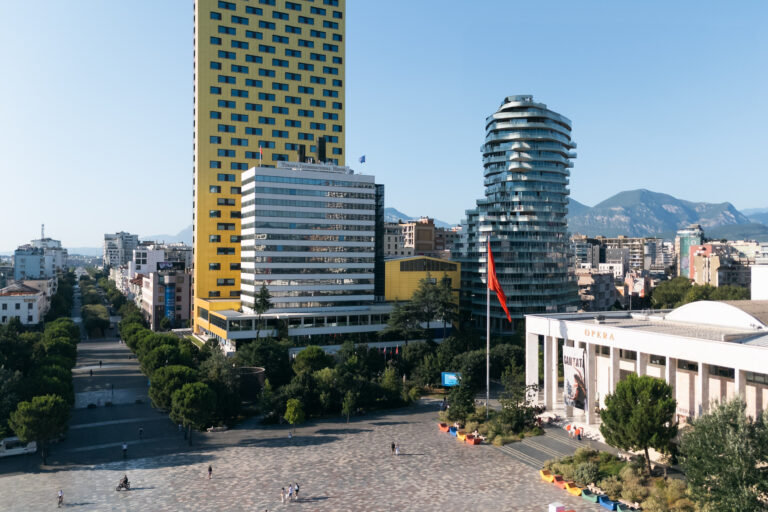
Trendy Blloku – best for nightlife
Stay in Blloku to be surrounded by trendy cafes and nightlife venues. Some of the streets may quite expectedly be a bit noisy at night, but you’ll be based in the most buzzing area still within a stone’s throw of all the sights.
I’ve stayed on the edges of Blloku (just north and west of it), which gave the perfect combination of a calm residential atmosphere with just a 5-minute walk to where the action is.

21 Dhjetori – local area
On my first stay in Tirana I based myself here west of the center, which I recommend for travellers on a budget or anyone looking for a more low-key area to stay.
Many hostels are located in 21 Dgjetori, including the excellent Tirana Backpackers Hostel where I stayed at the time. It feels a bit more like the ‘real city’ and it’s easier to find cheap eats here. Walk 15-20 min into town or take the bus for a couple of stops.
Heads up: 21 Dhjetori is mostly a chill residential spot, so don’t expect any fancy hotels. You’ll find modern apartments perfect for living like a local, and it’s just a 20-minute stroll to Blloku if you want the nightlife and city buzz.
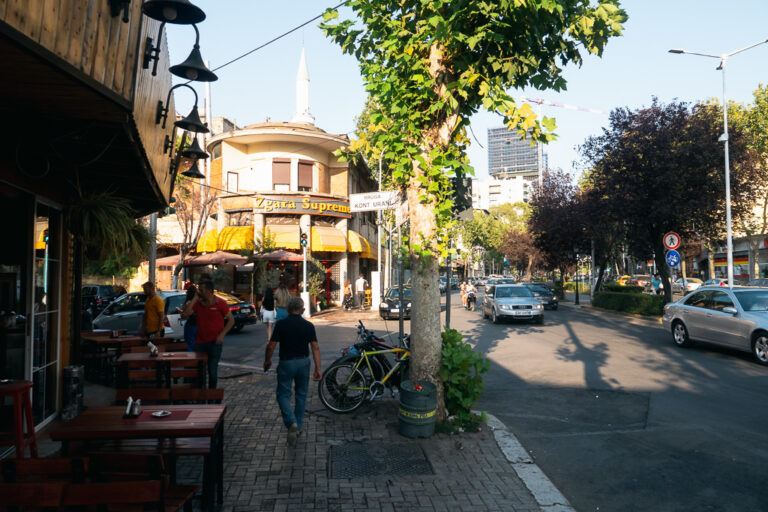
The best things to do (by theme)
Instead of going for the typical “things to do” unordered listicle here, I thought I’d group various experiences together to cover different aspects of Tirana.
You can read through the following sections to inform yourself of what makes Tirana unique, while also learning about the things to do along the way.
My tips are roughly in order of priority, from the essentials down to the nice-to-do’s if you have some extra time to spare.
Explore the reinvented city
Some tourists immediately dismiss Tirana as ‘modern’ and somehow not worthy of attention, but once you learn about the stunning caterpillar-to-butterfly transformation the city has gone through, you’ll appreciate it so much more.
That’s why to kick off your exploration you should really soak up the wonderful architecture and urban design first.
Like many formerly communist countries, Albania was left with a heavy architectural debt — and yes, some outer neighborhoods feature some unsightly socialist apartment blocks. But while I was ready to find only a crumbling grey city when I first visited Tirana, to my surprise I was met with a dynamic and creative cityscape that kept me constantly engaged.

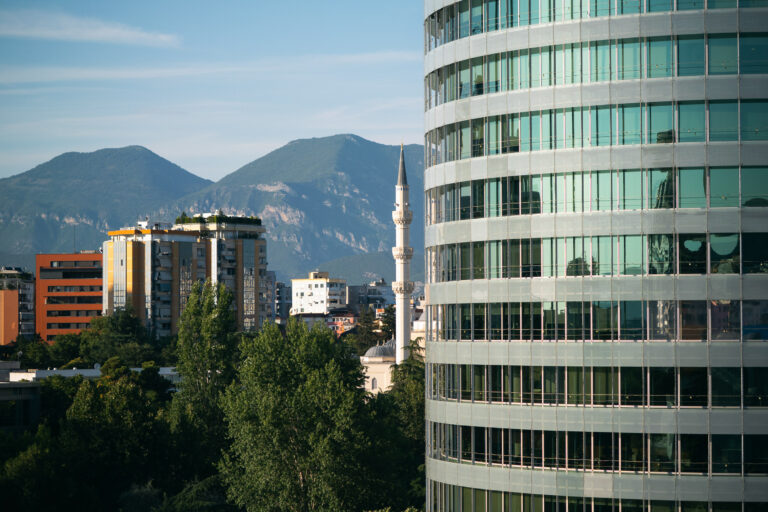
Tirana’s transformation is mainly credited to its one-time mayor Edi Rama (now Albania’s prime minister) whose background as an artist helped inspire it. What began at a small scale with repainting buildings in bright colors culminated in a city that’s now renowned for its urban renewal projects. It’s become a bit of a playground for architecture firms from around the world whose bold designs find a home here.
Here’s what I recommend to capture this aspect of Tirana:
Walking tour from Skanderbeg Square
Once a giant roundabout with horrific traffic, thanks to its renovation in 2019 and surrounded by greenery, this square now forms the wonderfully walkable heart of Tirana.
It’s here that you can most easily appreciate the past and the present. To one side you will see a statue of Skanderbeg, Albania’s near-mythological hero who led the revolt against the Ottoman Empire. Opposite you will see the Skanderbeg Building, which if viewed from the right angle will show the contours of Skenderbeg’s face. Also here you will see the National Historical Museum featuring a huge socialist mural mosaic above its doors.
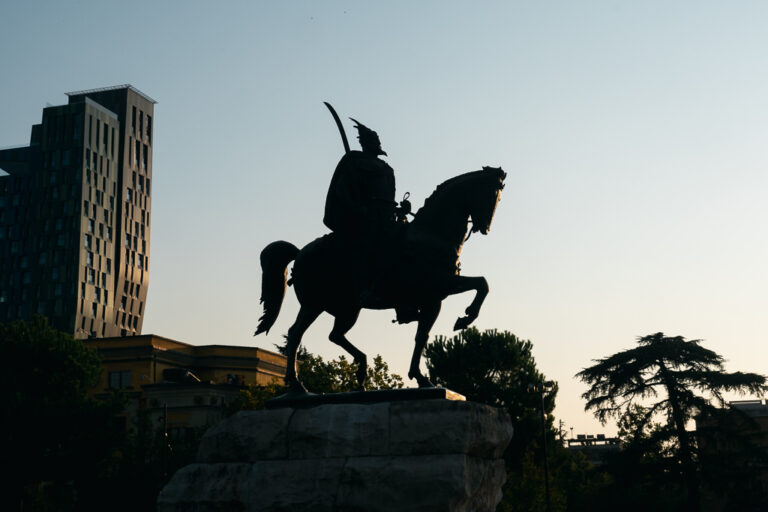
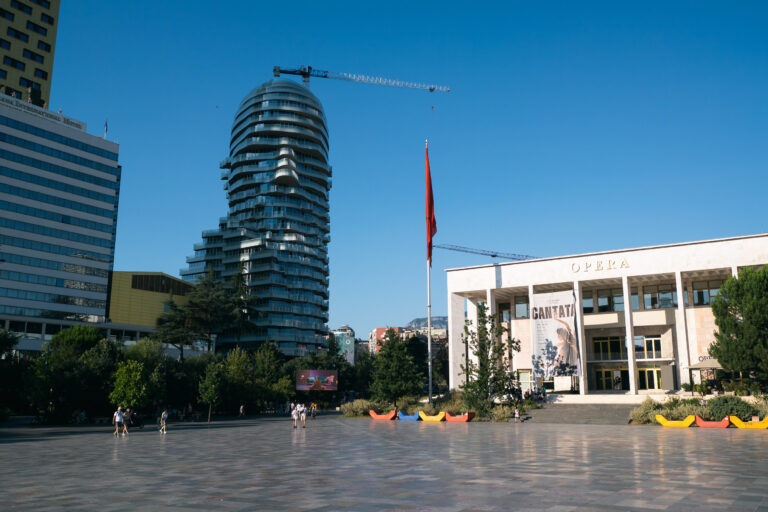
I love how this square is a mish-mash of different eras of Albania. The stones used to pave the square actually came from 30 different quarries around the country, symbolizing the unity of Albania.
While you can stroll around this area and gather your own impressions, what will hugely level up your understanding is participating in one of the many walking tours that start from here.
Heads-up: I booked a free walking tour through Guruwalk — the perfect introduction to Tirana. Though I waited until my third day, I wished I’d done it immediately upon arrival!
You can book a free walking tour on Guruwalk, which typically takes 2 to 2,5 hours and starts at different times throughout the day. I guarantee you will see the city with different eyes.
I loved knowing the stories behind some of the things you see in plain sight, but my tour also took me to some easily overlooked corners, including a back alley where communist-era statues of Lenin and Stalin where banished to.
Climb the Pyramid
The Pyramid of Tirana is another powerful symbol of the city’s transformation. Originally designed in honor of Albania’s dictator, in 2023 it was converted into a creative and cultural hub.
When I first visited Tirana in 2021 this place was still a completely abandoned ruin, only used as an unofficial skatepark and graffiti ground, so it was a positive shock to see what it’s been turned into.
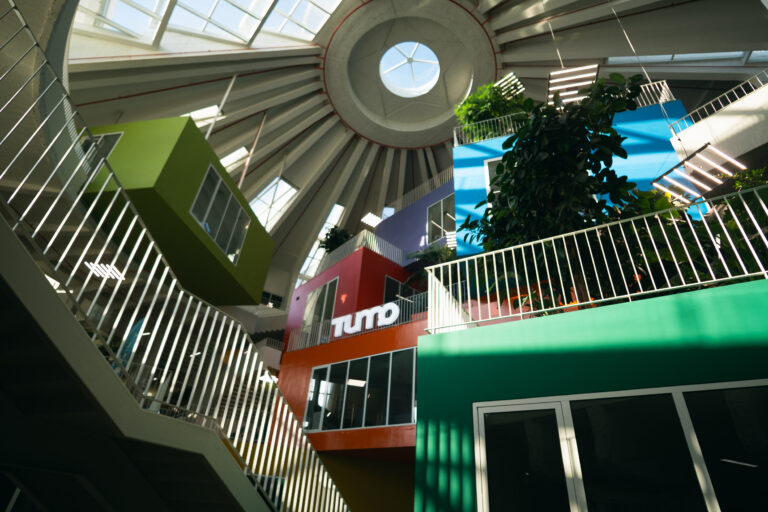

The original pyramidal structure was kept, but new colorful blocks were added in and around to house small cafes and book stores. Stairs let you fully climb to the top from where you can get some amazing views of the city and the Dajti mountains in the background.
It’s worth climbing the 100+ steps and taking in the bold design. You can also step inside the building. It serves as a startup hub so it isn’t of tourist interest, but you might still want to see what the unusual interior of the structure looks like. You may notice bits of reinforced concrete that were deliberately left exposed, serving as reminders of the original building.

Learn about Albania’s dark past
Did you know that Albania was once dubbed ‘the North Korea of Europe’?
While the analogy isn’t perfect, it’s true that for decades Albania was hermetically cut off from the world. Despite being communist it wasn’t part of the Soviet block; it actually broke off all contact with the USSR, the West, Yugoslavia, and then even China — rarely letting citizens in or out.
The country suffered an extremely authoritarian and isolated regime under the dictator Enver Hoxha, who became so paranoid as to have over 100,000 (!) pillboxes and bunkers constructed all over Albania.
Two such bunkers in Tirana were turned into museums, letting you literally descend into Albania’s dictatorship years. Through information displays, objects, and a few interactive elements, they’ll give you a real sense of what life was like under the highly repressive system. This is not only interesting in terms of learning about Albania’s past, but offers powerful lessons and reminders about our world today.
There are actually three museums in Tirana that delve into this subject. Most visitors probably only visit one, but I went to all three so I can give you the lowdown here.
Bunk’art 2
This smaller bunker is located close to Tirana’s main square, making it the easiest to visit. This does also makes it a lot busier inside the cramped underground tunnels and rooms. If you don’t have time for the other museums, I do recommend Bunk’art 2.
It’s mostly a sequence of small rooms with information panels and photos. Spy gear used during the regime and other objects of interest are also featured.

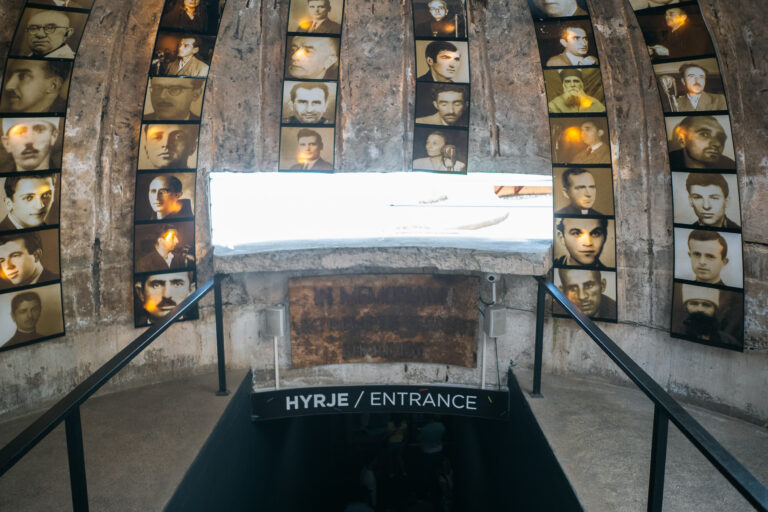

Bunk’art 1
Located about a 20 minutes drive’ northeast of the center, this bunker is much more expansive than the second location. It was built as a shelter for dictator Enver Hoxha and his innermost circle in case of nuclear attack, featuring a maze of quarters and offices, a mess hall, and a series of blast doors and decontamination chambers.
It is just a tad less information-dense than Bunk’art 2, but I found the spaces a lot more interesting and highly worth the trip. Both locations are good, but I personally recommend Bunk’art 1 over 2.
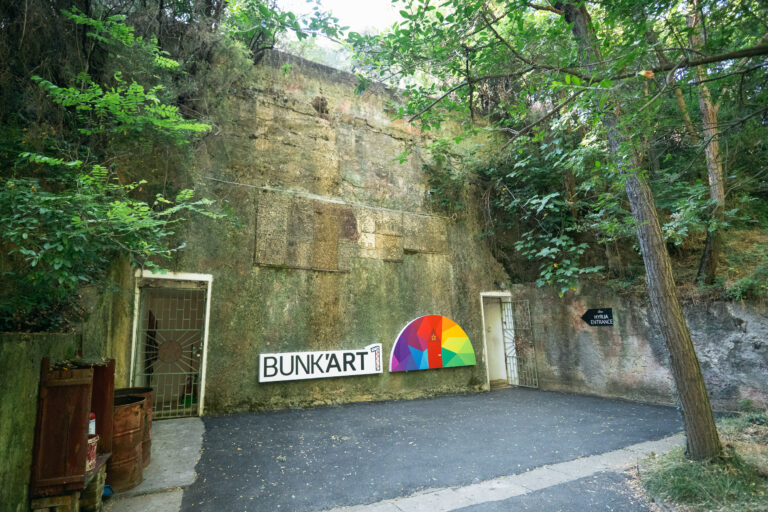
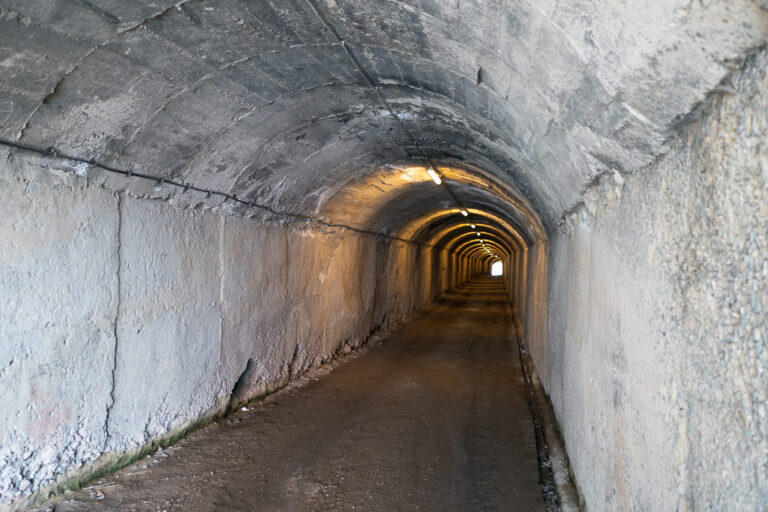

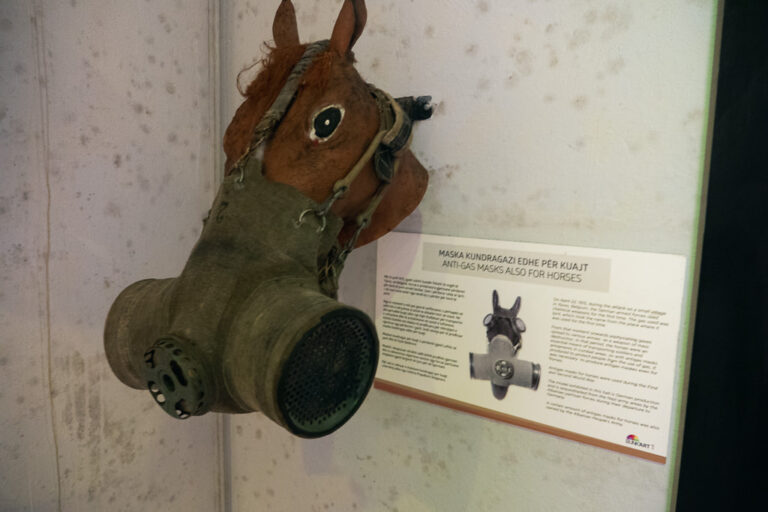
How to get to Bunk’art 1: I’ve visited it twice, once by bus and once by taxi. If you’re on a budget, go to Tirana’s central bus station near Skanderbeg Square and take the bus to Porcelan which goes every 5-20 minutes. Get off at the last stop, “Dajti Ekspres”, which refers to the cable car that is also here. It’s another 10-minute walk or so to Bunk’Art. The fare should be around 40 Lek (about 0.5 Euro)
By taxi is easiest, but may cost around 700 to 900 LEK/7–9Euro depending on traffic. Using the local taxi app Patako can end up being cheaper. (Details in the travel tips section.)
P.S. I spoke to a traveller who’d skipped the Bunk’art believing them to be art exhibits and not of interest to them — but apart from one or two installations, they are NOT art spaces. They’re squarely focused on remembering Albania’s Stalinist regime, so the names are maybe a bit awkwardly chosen. I think visiting at least one of them is a must-do in Tirana.
House of Leaves
This newer museum appears to be less-known and isn’t mentioned on blogs as often but it’s highly worth visiting.
The residential villa that it’s housed in was once a medical clinic that then secretly became the headquarters of Albania’s state security. The museum focuses on the extreme surveillance that was carried out as well as the interrogation techniques used by the Directorate of State Security.
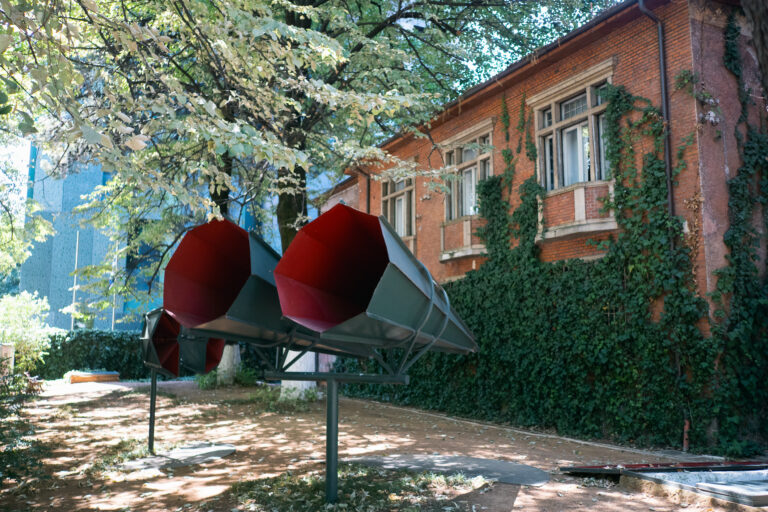

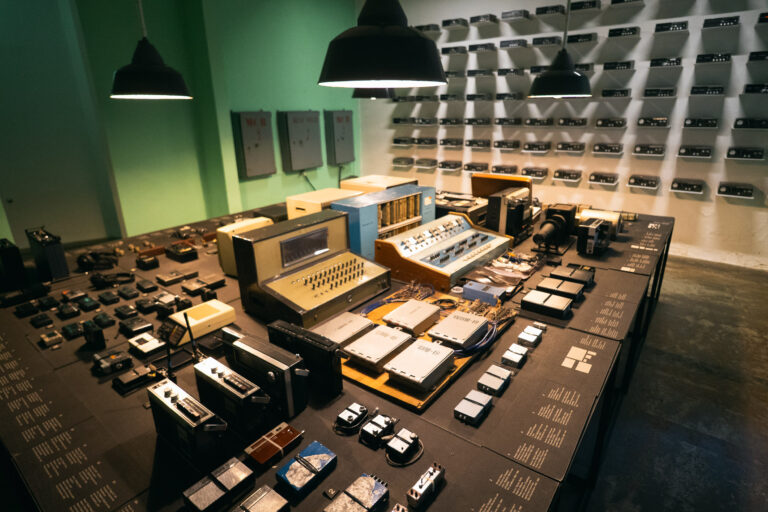
I found this museum very moving and also much appreciated the amazing design of the exhibitions, which include bugged rooms, a darkroom, and an interrogation room. It lets you truly experience the story and not just read it from information panels.
If you’re at all interested in the subject matter I highly recommend the House of Leaves, which weirdly feels like a ‘hidden gem’ even though it’s so close to the main square, probably due to simply being overshadowed by the more well-known Bunk’arts.
My take: If you’re not in a rush, I recommend making at least the trip to Bunk’Art 1 and then checking out the House of Leaves if you can spare another hour or two. If you’re on a longer stay in Tirana you could even visit all three: while dealing with similar subjects, they’re all different and don’t overlap.
Get a taste of Albania’s traditional culture
HIGHLIGHT!
Tirana is NOT just about the dark communist era.
Here’s something that is guaranteed to leave you energized and smiling from ear to ear, while experiencing something that is truly Albanian.
Albanian Nights was started by locals who noticed how ‘dark tourism’ dominates the typical Tirana itinerary. It means that many tourists end up missing out on other (more positive) aspects of its culture and arts. It led them to found Albanian Nights as a cultural center teaching visitors all about Albanian traditions, customs, gastronomy and history.
Sounds stuffy? Well, it’s quite the opposite.
This might be the most unfiltered fun I’ve had in Tirana!



The centerpiece is an evening show of song and dance closely mirroring what you’d see at a traditional Albanian wedding. But rather than just passively watching a show, you are very much invited to participate.
As a guest you’ll get to wear the same traditional Albanian costumes. Not only that, by the end of the night you’ll find yourself dancing all in a big circle, mingling with the professional performers on stage. It’s a captivating and energetic show that is sure to leave you buzzing.
The venue with wooden floors and walls with wooden crossbeams instantly makes you feel like you’ve been transported to a mountain village. The story that weaves through the performances is based on traditional Albanian folklore, though the host keeps it light through skillful use of improvised humor and audience interaction.

They’ve really created what I would easily call a magical and immersive experience that is a must if you’re in Tirana. You have two options for the show:
Apart from the show venue there is also a large souvenir ‘bazaar’, bringing together craft and art from around the country. While some of the items may be pricey if you’re on a budget, I appreciated having the assurance that all of the products for sale here come from genuine local artists and craftspeople — not a factory in China.
The show is fast becoming one of the most popular activities in Tirana, so it’s important to book this ahead of time. You can make your reservation via popular booking platforms like GetYourGuide if you already have an account there, but I actually recommend booking directly with Albanian Nights so you support their mission of sharing Albanian culture.
Blloku and bar & cafe scene
From the architecture and bunkers to wedding dances, the next best aspect to enjoy of Tirana is undoubtedly its energetic restaurant and nightlife area.
Blloku (the Block) was once a prestigious residential area reserved for party elites during Enver Hoxha’s rule. Today, it is the most happening area of Tirana, densely dotted with all manner of third wave cafes, trendy juice bars, clubs, and pubs. Stroll around the nine-or-so streets of Blloku and you might imagine faint echoes of Berlin or, say, the Roma district in Mexico City — only at a much humbler scale.
It’s in this electric neighborhood that you can browse trendy shops and galleries, find international food like poke and texmex, and soak up fancy cocktails at night (for instance at Tiki Bar or Nouvelle Vague).



Although it’s mostly upscale, prices are reasonable by Western or Northern European standards. At Nouvelle Vague most cocktails cost 8 EUR.
When I had breakfast at a trendy and thoroughly pothos-covered cafe, I paid about 9 EUR for triple-stacked Pistachio pancakes with single-origin coffee — surely significant for Albania (where the minimum wage is around 400 EUR), but not so shocking for a foreign visitor from a high-income country.
Blloku may not be the best place for soaking up traditional Albanian culture, but it’s the perfect area for food and fun — and it’s one of the reasons I think Tirana is so tourist-friendly.
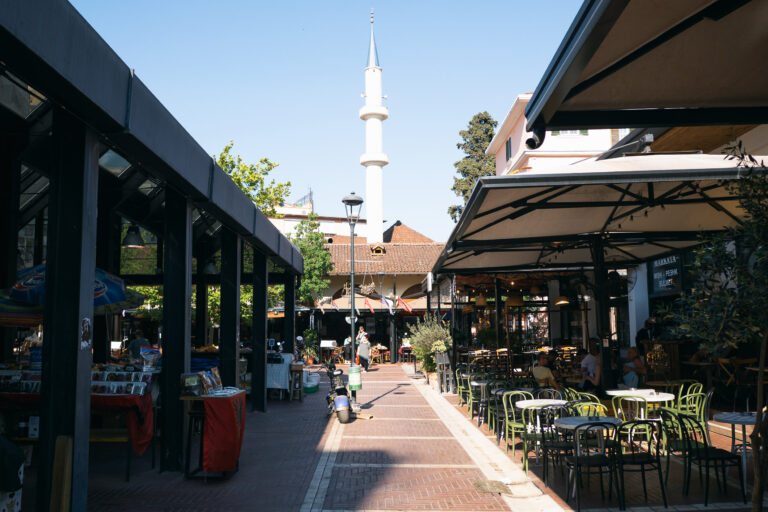
Besides Blloku there are other spots to go. I would personally skip the Tirana Castle restaurant court which is very pricey and feels somewhat artificial. But the New Bazaar may be worth a look — it’s a market square where you could pick up some souvenirs or enjoy food or drinks on one of the surrounding terraces.
Along the pedestrianized Murat Toptani promenade there are also lots of dining places with outdoor seating, often cooled with misting systems in summer. It’s a really nice area to be in the evening.
My restaurant & bar recommendations:
- Oda’s Garden is the much-tipped place for traditional Albanian food like stuffed eggplant or lamb stew. Many tourists are obviously sent here and entertainment is offered in the form of Albanian folk musicians. Prices are relatively high but it offers a great immersive experience. There’s also the similarly named Oda Restaurant, but I’m not actually sure if it’s a copycat or if they’re sister restaurants.
- Gjelltore SaUku – I’m glad I got this tip from a local for cheap traditional Albanian cuisine with an unassuming brightly-lit ambiance. I happily extend this recommendation for budget travellers or anyone seeking a more local foodie experience.
- Noor Coffee & Fine Food. This cafe-slash-gastro-pub became a frequent pitstop for me while wandering the city. Sit inside or in the upper terrace among the trees. Really nice vibe and friendly service.
- Komiteti Bar is the perfect place to go for drinks outside of Blloku. It has a wonderfully warm and detailed bohemian space with a great rooftop area. There’s a huge selection of Raki, the Albanian spirit usually made with plums or mulberries.
- Oborri is a cosy casual restaurant and cocktail bar with a leafy garden in 21 Dhjetori, the budget-friendly neighborhood west of center. Various yummy tacos and cocktails starting at 600 LEK.
Relax at sunset in Tirana Lake Park
Exhausted from all your sightseeing? Then wind down in Tirana’s huge lakeside city park. Roughly the size of New York’s Central Park, it’s within 20-minute walking distance of Skanderbeg Square (and close to Blloku), letting you easily escape the city at any time.
I know this is not really a typical ‘tourist activity’, but one of my favorite things to do in cities is just to go to the parks and see what goes on there.
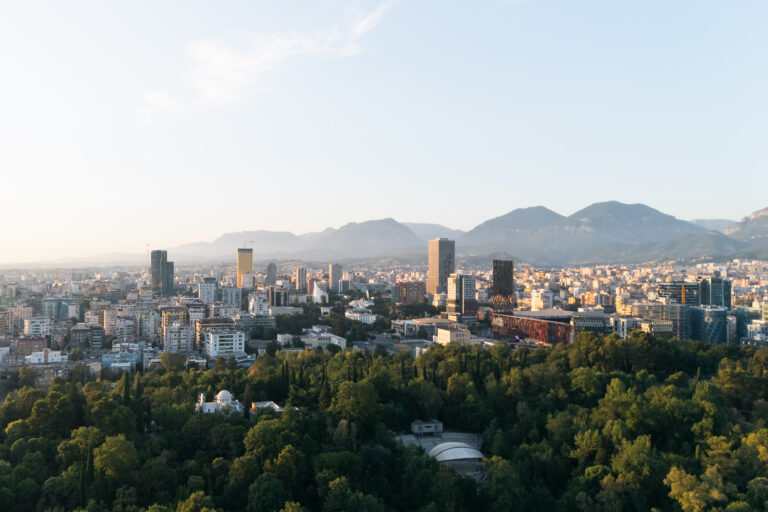
When I last visited Tirana during a heatwave and loved slowing down and observing the summer evening vibes and sipping an ice cold Birra Tirana at Lake View Bar. I watched the setting sun over the lake while families were out for a stroll, joggers brought their dogs along for a run, and kids recorded dancing Tiktoks in front of the lake and green mountain backdrop.
Along the lakeside are some sporting areas, a mini golf course, and picnic areas, so things get very lively and it’s a lot of fun to walk around here if you enjoy some people-watching. Circling within the forest also makes for a nice hike and I spotted several lizards and turtles along the way.


Inside the forest are cute fairylight-strung cafes/bars like Foresta Grid and The Hills. You’ll also find here the George W. Bush Library, which is a bit of a peculiarity if, like me, you remember this former US president mostly for his disastrous war in Iraq.
However, “dubya” is widely admired in Albania for his 2007 visit to Tirana and for supporting Kosovo’s independence (which is home to many ethnic Albanians), so you may see his name here pop up from time to time.
Sights & museums not about the dictatorship
The dictatorship museums of Bunk’Art and the House of Leaves capture most visitors’ attention and honestly I think these should really be your priority, especially if it’s your first time in Albania. But if you have some time to spare, there are some other museums and historical sites to check out in Tirana.
Vila 31 x Art Explora – This pastel-colored 1960s-style villa in the middle of Blloku was once the private residence of Enver Hoxha, Albania’s dictator. It used to be abandoned, the kind of place that gets pointed out briefly during city walking tours, but it’s now been turned into a contemporary art space. I love how such a loaded place has been returned to the public and given a new life.
Et’hem Bey Mosque – An 18th century mosque with impressively detailed frescoes inside. It can be visited by anyone, including non-Muslims, so long as you respect certain etiquette. Entry is free.
National Gallery of Fine Arts – It’s closed until 2026 for extensive renovations, but I list it here for completion. The museum will be completely modernized with an immersive experience, so I look forward to checking it out on a future visit. Until then, you can still walk around the ‘Cloud’ installation in front of the building, an interesting art structure with multiple levels that is lit up at night.
Tirana National Archaeological Museum – This is a calm and uncrowded museum, not on the typical tourist circuit despite having a wide-ranging collection of artifacts from the prehistoric era to the Middle Ages. Lots of display cabinets here with unfortunately not much explanation, so you have to find your own meaning in the pots, shards, and weapons on display. I would rate this a lower-priority suggestion if you’re on a longer-term stay in Tirana.
Explore beyond the city limits
Tirana can keep you captivated for days, but there is more to see in the areas around it.
Arguably the easiest way to ‘zoom out’ from the city is with the Dajti Express, a cable car spanning 5km taking you near the summit of Datji mountain in about 15 minutes.
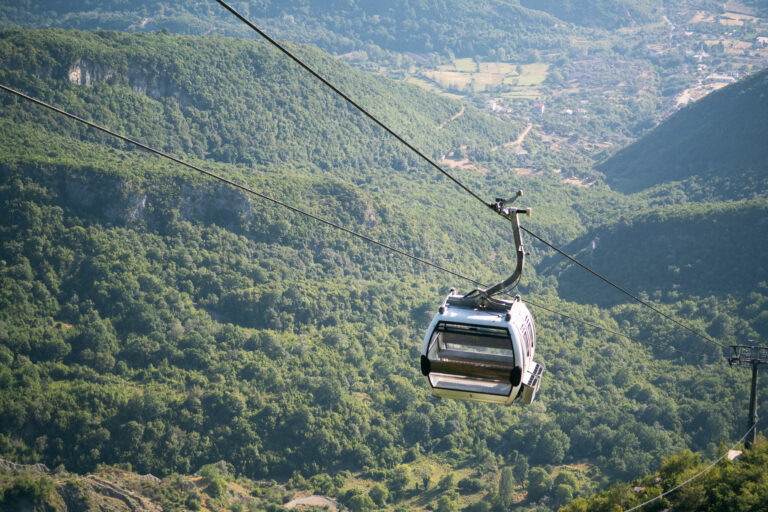
I’ll be honest though: I found the Dajti Express a little underwhelming. It costs a lot for Albania (around 1200 Lek or €12 per person return) and the upper station wasn’t quite as scenic as I’d expected. There’s a hotel, a mini golf course, and a few other minor attractions.
I had the sense that it’s a nice place for locals to escape the summer heat and enjoy some cool air, but it’s maybe not a must-see. Oh, the cable car closes at 6 pm, so you can’t go up the mountain for sunset views.
Perhaps if you were starting a hike from here, it would be a different story. There is a hike to Tujanit peak that I only learned about later that would have made this trip a lot more worth it for me. Still, I would prioritize the day trips outside of Albania and keep the cable car as a last thing to tick off the list.
A better way to explore from Tirana is with two excursions…
Bovila Lake & Gamti Mountain Day Tour: If it’s nature you seek, then this is the best nearby destination — about 1 hour north of Tirana. This day tour takes you on a hike up Gamti Mountain. Along the way, you’ll catch sweeping views of Bovilla Lake. The climb is moderate and rewarding, and on the way back, you can cool off with a refreshing swim in the river if you like.
book this hike on viatorVisit the ancient walled town of Krujë: About 1 hour north of Tirana, you can visit Krujë as part of a tour, or you can travel there yourself with one of the hourly furgon minivan services from Tirana’s Northern Bus Terminal. The hilltop castle offers expansive views and was once the home of Skanderbeg, the national hero of Albania. The old town is small enough to explore by foot and includes two small museums. It’s great for a morning or afternoon halfday trip.
This day trip from Tirana takes you to Krujë, where you’ll visit the hilltop Sari Salltik shrine for sweeping mountain views, explore Krujë Castle and the Skanderbeg Museum, and wander the lively Old Bazaar filled with local crafts before heading back to the city.
book this tour on getyourguideTransport in & around Tirana
Exploring the center
Between the center around Skanderbeg Square, the hip Blloku neighborhood, and Lake Park, Tirana is wonderfully walkable. If you don’t mind exploring on foot, you can reach most places just by strolling around. If your feet get tired, you can use a short taxi ride or one of the electric scooter apps to cover more ground.
Just be aware that drivers in Tirana have very little respect for pedestrians. Crosswalks or zebra crossings don’t guarantee they will actually stop for you, so take care when crossing the street.

Getting in and out
Tirana is lovely when you’re inside it, but it’s honestly a real pain to get in and out of. In all of the 5 times I had to get in or out, I got delayed or stuck in traffic.
Anywhere outside the highly walkable central bubble you’ll be reminded that Albania is still very much a developing country. Arterial roads seem perpetually choked with traffic, sometimes with 4 cars driving parallel where there’s only 3 lanes. It’s a bit of a mess!
Arrival from the airport: Tirana Airport itself is modern and your arrival should be smooth, but getting to the center may not always be as efficient. The theoretically 30-minute ride can easily turn into an hour depending on traffic. You could take a taxi, but it might be more comfortable to take the bus. When exiting the arrivals hall walk straight past the taxis to the back of the lot where shuttle coach buses depart every hour.
Onward travel via the bus station: Okay, how do I say this delicately? Um, Tirana’s bus station is an absolute shitshow. Even dirt poor Bolivia has better bus stations than what you’ll find here, which is basically just a plain parking lot without any infrastructure at all (no bays, signs, or any departure boards). I wouldn’t blame even experienced travelers for getting a little confused here.
Look for signs in the windshields of the buses and minivans or just yell out your destination and see if anyone approaches you. Note that online timetables for buses are not always reliable in Albania and it’s often worth asking at your hotel/hostel/apartment what leaves where at which time. A new bus station is under construction, so hopefully the situation will improve.

I should mention that some furgons (minibuses) actually leave from the street outside of the bus station. A bus driver actually grabbed my arm and physically guided me to the street in front to help me find the correct furgon, something I was grateful for as I would have never figured it out on my own. The popular destinations (e.g. Gjirokaster or Shokder) will have regular departures throughout the day, so you can often improvise and not have to wait for that long, but it is a bit chaotic.
Using taxis: I had expected the taxis to cost less in Albania than they do (they’re actually a bit cheaper in Portugal where I live) but they can definitely help you get to sights outside of the immediate center. Most of the taxis are modern and comfortable, with surprisingly many electric taxis on the streets. Make sure the meter is used to avoid potential scams.
Using ride-hailing: Apps like Uber or Bolt don’t work in Albania, but you can use the local equivalent called Patako.
I’ve found fares to be generally about 20-25% cheaper than taxis and I like knowing the cost in advance. You have to approve rides at the end in order to unlock payment, so be sure to have mobile data or ask the driver to hotspot you so you can finalize the trip.
While getting around within Tirana or in Albania can sometimes be a bit frustrating or confusing, in the end this is just a trade-off when travelling in a developing but highly budget-friendly country.
The bus station will hopefully get an upgrade soon, but I should say that travelling by bus or furgon has otherwise been trouble-free for me.
Tirana is just the start of your Albania adventure and from here you can easily jump to many other destinations, including the Albanian Riviera or the historical cities of Berat or Gjirokaster, and the northern cultural and trekking base of Shkodër.
So there you have it — all my best tips for Tirana. Excited to explore the rest of Albania? Then don’t miss my in-depth guide to Albania, the historical city of Gjirokaster, or hiking in the Albanian Alps.


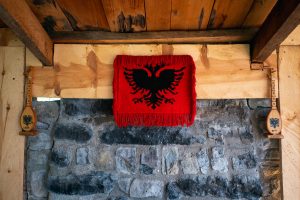
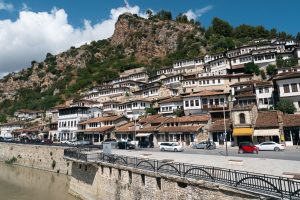
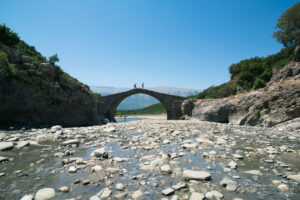

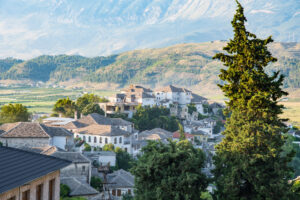

All comments are moderated before they appear.